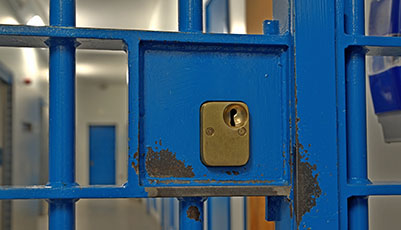
April 5, 2017, New York, NY – As counties and cities around the country look for ways to reduce the levels of pretrial detention, a new report from the Misdemeanor Justice Project (MJP) at John Jay College of Criminal Justice examines trends in custody status including bail amount set, length of stay, and discharge status for individuals admitted to the New York City Department of Correction (DOC) from 2000 to 2015. According to the study, the average pretrial length of stay increased significantly over a fifteen year period, 2000 to 2015, even as the admissions for pretrial detention decreased by almost half.
President Jeremy Travis and Professor Preeti Chauhan presented key findings of the report this morning at a forum co-sponsored by the Citizens Crime Commission of New York City.
“With the support of Mayor de Blasio and Speaker Mark-Viverito, the Lippman Commission’s recommendation for significant reductions in the City’s jail population now moves from concept to implementation. Two overarching findings of this report shed light on that challenge,” said President Travis. “First, as the number of New Yorkers held in Department of Correction custody has dropped sharply over twenty years, the profile of admissions to corrections custody has changed dramatically. Second, even though average bail amounts and length of stay have increased, the analyses reveal many areas for reform that could further reduce the DOC population. Given the broad-based support for the goal of reducing New York’s jail population, the stage is set for the next chapter in criminal justice reform.”
The report, Trends in Custody: New York City Department of Correction, 2000-2015, shows that the profile of those admitted to DOC custody changed in important ways. The incoming cohorts were less likely to be admitted for felony drug charges. Further, the admissions cohorts reflected a higher percentage of individuals charged with violent crimes. By 2015, the highest crime category was admission for violent crimes.
“Understanding trends in custody is complex and impacted by the characteristics of those coming through the front door of corrections,” said Professor Chauhan. “In this report, we examine trends in bail amount, length of stay and discharge status by charge level and category, demographics and borough, and seek to provide background information about how the pretrial admissions population has changed over time. We hope this report adds to a better understanding of those detained pretrial in New York City; an understudied group.”
Key findings of the report include:
- The average pretrial length of stay increased significantly, from 40 days to 55 days. The average pretrial length of stay for felony admissions increased from 62 days to 80 days and for misdemeanor admissions from 13 days to 17 days.
- For pretrial admissions, the charge categories with the largest increases in pretrial length of stay were violent crimes, burglary, and weapon charges. The average pretrial length of stay for violent crimes increased from 89 days to 119 days (a 34.9 percent increase), for burglary increased from 71 to 96 days (a 35.1 percent increase), and for weapon charges increased from 40 to 72 days (a 78.4 percent increase).
- The average bail amount set for pretrial admissions more than doubled, from approximately $7,800 to $16,800. Average bail amounts increased for felony admissions ($12,600 to $26,000) and misdemeanor admissions ($1,500 to $2,100).
- For pretrial admissions, the highest proportion of discharges were for bail paid, 30.3 percent in 2000 and 35.4 percent in 2015. Discharges for ROR, the second highest proportion of discharges, accounted for 23.3 percent in 2000 and 21.5 percent in 2015. The average length of stay for these discharge categories increased from 10 days to 14 days and 30 days to 36 days, respectively.
- Pretrial admissions that resulted in a transfer to state prison had the highest bail amount set and highest average length of stay. Notably, the average bail amount set this category increased from $22,560 to $74,253, an almost three-fold increase (229.1 percent); and the average length of stay increased from 170 days to 284 days, a 66.4 percent increase.
“Even as our city experiences record low crime, we still have much more work to do to improve our criminal justice system - especially when it comes to pretrial detention,” said Richard Aborn, President of the Citizens Crime Commission of New York City. “And, as New York looks to close Rikers Island in the next decade, reforming pretrial detention is a critical step towards making our city more safe, just, and compassionate. The John Jay report clearly highlights the urgent need to change the way we detain individuals accused of a crime, each of whom has a right to a speedy trial granted by the 6th Amendment. I would like to thank John Jay for putting forth this insightful and important report.”
The complete data analyses are documented in a full report which is available here.
With funding by the Laura and John Arnold Foundation, this is the sixth report prepared by the Misdemeanor Justice Project, a research initiative at John Jay College headed by Professor Chauhan that includes faculty, graduate students and staff. Previous MJP reports have focused on trends in police enforcement practices and trends in corrections. All reports are part of a series released with the Citizens Crime Commission. To access all the MJP reports, please visit the website at www.jjay.cuny.edu/mjp.
About John Jay College of Criminal Justice: An international leader in educating for justice, John Jay College of Criminal Justice of The City University of New York offers a rich liberal arts and professional studies curriculum to upwards of 15,000 undergraduate and graduate students from more than 135 nations. In teaching, scholarship and research, the College approaches justice as an applied art and science in service to society and as an ongoing conversation about fundamental human desires for fairness, equality and the rule of law. For more information, visit www.jjay.cuny.edu.



